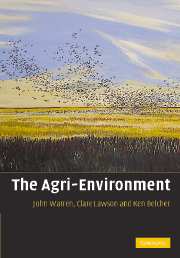Book contents
- Frontmatter
- Contents
- Preface and Acknowledgements
- 1 An introduction to agro-ecology
- 2 Agricultural support and environmentalism
- 3 Environmental impacts of agriculture
- 4 Principles behind agri-environment schemes
- 5 Farm conservation planning
- 6 Habitat management
- 7 The management of agricultural wastes
- 8 Low-impact farming systems
- 9 Landscape and farmscape ecology
- 10 The future of agri-environmental systems
- Glossary
- References
- Index
Preface and Acknowledgements
Published online by Cambridge University Press: 08 December 2009
- Frontmatter
- Contents
- Preface and Acknowledgements
- 1 An introduction to agro-ecology
- 2 Agricultural support and environmentalism
- 3 Environmental impacts of agriculture
- 4 Principles behind agri-environment schemes
- 5 Farm conservation planning
- 6 Habitat management
- 7 The management of agricultural wastes
- 8 Low-impact farming systems
- 9 Landscape and farmscape ecology
- 10 The future of agri-environmental systems
- Glossary
- References
- Index
Summary
Historically agriculture has been considered purely as the method by which humans produced most of their food, fibres and other natural products. This activity has dramatically altered the farmed environment, favouring some species and habitats and degrading or destroying others. Over time as the human population has grown and agricultural activity has intensified the magnitude of this effect has increased, resulting in recent rapid declines in the abundance of many species and in the conversion of semi-natural habitats to monocultures. Population crashes in many of the species associated with farmed land and reductions in the quality and quantity of ecological services delivered by farmed land have resulted in an awareness that agriculture produces much more than just food. This realisation combined with other pressures such as reducing and decoupling economic subsidies from food production and changes in consumer demands for ecological goods and services are driving a second truly green revolution within the agricultural industry. New understanding of the ecology of the impacts of agriculture at a range of levels is enabling multifunctional production systems to be designed that deliver quality food products while supporting biodiversity and maintaining ecological services. Everyone involved in the agricultural industry during the twenty-first century will need an understanding of how to balance these conflicting demands.
This book has been written for agricultural and conservation students and researchers and for those actively involved in balancing food production with on-farm conservation.
- Type
- Chapter
- Information
- The Agri-Environment , pp. vii - viiiPublisher: Cambridge University PressPrint publication year: 2007



